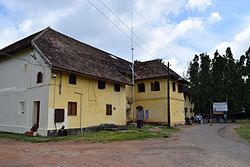
Chendamangalam is a small town and a panchayat in Paravur Taluk, Ernakulam district in the state of Kerala, India.

Ernakulam is one of the 14 districts in the Indian state of Kerala, and takes its name from the eponymous city division in Kochi. It is situated in the central part of the state, spans an area of about 2,924 square kilometres (1,129 sq mi), and is home to over 9% of Kerala's population. Its headquarters are located at Kakkanad. The district includes Kochi, also known as the commercial capital of Kerala, which is famous for its ancient churches, Hindu temples, synagogues and mosques.
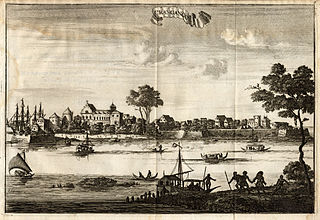
Kodungallur is a historically significant town situated on the banks of river Periyar on the Malabar Coast in Thrissur district of Kerala, India. It is 29 kilometres (18 mi) north of Kochi (Cochin) by National Highway 66 and 38 km (24 mi) from Thrissur. Kodungallur, being a port city at the northern end of the Kerala lagoons, was a strategic entry point for the naval fleets to the extensive Kerala backwaters.

The Kingdom of Cochin, also known as the Kingdom of Kochi or later as Cochin State, named after its capital in the city of Kochi (Cochin), was an Indian Hindu kingdom in the central part of present-day Kerala state. It commenced at the early part of the 12th century and continued to rule until its accession to the Dominion of India in 1949.
Paliath Achan or Paliyath Achan is the name given to the male members of the Paliam royal family, a Nair/Menon chieftain family from the Indian state of Kerala who were elevated to the status of royalty by the Rajah of Kingdom of Cochin (Kerala), since the family figured prominently in the history of the region.

The Paradesi Synagogue aka Cochin Jewish Synagogue or the Mattancherry Synagogue is a synagogue located in Mattancherry Jew Town, a suburb of the city of Kochi, Kerala, in India. It was built in 1568 A.D. by Samuel Castiel, David Belila, and Joseph Levi for the flourishing Paradesi Jewish community in Kochi. Cochin Jews were composed mainly of the much older Malabari Jews and the newly arrived Sephardic refugees from the Portuguese religious persecution of Jews in Spain and Portugal. It is the oldest active synagogue in the Commonwealth of Nations. Paradesi is a word used in several Indian languages, and the literal meaning of the term is "foreigners", applied to the synagogue because it was built by Sephardic or Portuguese-speaking Jews, some of them from families exiled in Aleppo, Safed and other West Asian localities.
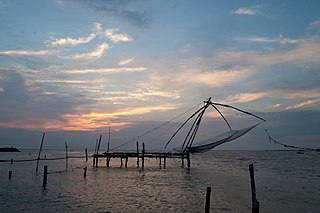
Fort Kochi, also known by its former name Fort Cochin is a neighbourhood of Cochin (Kochi) city in Kerala, India. Fort Kochi takes its name from the Fort Manuel of Cochin, the first European fort on Indian soil, controlled by the Portuguese East Indies. This is part of a handful of water-bound islands and islets toward the south-west of the mainland Kochi, and collectively known as Old Cochin or West Cochin. Adjacent to this is the locality of Mattancherry. In 1967, these three municipalities along with a few adjoining areas, were amalgamated to form the Kochi Municipal Corporation.

Mattancherry, is a historic ward of Kochi, Kerala. It is about 9 km south-west from the city centre. Mattanchery is home to many sites of historical and cultural significance, including the Paradesi Synagogue- which was the centre of life in the Jewish Quarter. In addition to the Cochin Jews and Paradesi Jews, Mattanchery is also home to Konkanis and Gujaratis, with the Gujarati street in Mattancherry being a cultural icon for Keralite Gujaratis.

The Kochi Municipal Corporation is the municipal corporation that manages the Indian city of Kochi in the state of Kerala. The Corporation manages 94.88 km2 of Kochi city and has a population of 677,381 within that area. It is the most densely populated city corporation in the state. Kochi Municipal Corporation has been formed with functions to improve the infrastructure of town.

Kochi is a city located in the Ernakulam District in the Indian state of Kerala about 200 km from Trivandrum, the capital of Kerala.

Thiruvankulam is a census town and revenue village in Thrippunithura municipality, in Ernakulam district, Kerala, India. The area is a part of the Kochi metropolitan area. NH 85 passes through Thiruvankulam. The Karingachira junction is the location of the southern terminus of the Seaport-Airport Road, which connects the Cochin International Airport and the Cochin Port.
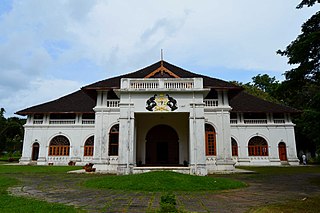
Shakthan Thampuran Palace is situated in City of Thrissur in Kerala state, India. It is named as Vadakkekara Palace, was reconstructed in Kerala-Dutch style in 1795 by Ramavarma Thampuran of the erstwhile Princely State of Cochin, well as Sakthan Thampuran is preserved by Archaeological Department. The palace was converted into a museum in 2005 by State.
Jainism, one of the three most ancient Indian religious traditions still in existence, has very small presence (0.01%) in Kerala, in south India. According to the 2011 India Census, Kerala only has around 4500 Jains, most of them in the city of Cochin, Calicut and in Wayanad district.

Hill Palace is an archaeological museum and palace located in the Thrippunithura neighbourhood of Kochi, Kerala. It is the largest archeological museum in the state and was the imperial administrative office and official residence of the Cochin Maharaja. Built in 1865, the palace complex consists of 49 buildings spreading across 54 acres (220,000 m2) and built in the traditional architectural style. The complex has an archaeological museum, a heritage museum, a deer park, a pre-historic park and a children's park.

Krishnapuram is a village in Alappuzha district in the Indian state of Kerala.

The Krishnapuram Palace is a palace and museum located in Kayamkulam near Alappuzha in Alappuzha district, Kerala in southwestern India. It was built in the 18th century by Anizham Thirunal Marthanda Varma, the Travancore kingdom. It is built in the architectural style of Kerala with gabled roof, narrow corridor and dormer windows, near the Krishnaswamy Temple at Krishnapuram.

Kerala architecture is a style of architecture found in the Indian state of Kerala, and in parts of the Tulu Nadu region of Karnataka. Kerala's architectural style includes a unique Hindu temple architecture that emerged in southwestern India, in slight contrast to Dravidian architecture practised in other parts of southern India. The architecture of Kerala has been derived from Indian Vedic architectural tradition and forms a part of Dravidian architecture, one of the three styles of temples mentioned in the ancient books on Vastu Shastra. The Tantrasamuchaya, Thachu-Shastra, Manushyalaya Chandrika, and Silparatna are all architectural treatises that have had an impact on the architecture of Kerala. The Manushyalaya Chandrika, a work devoted to domestic architecture, has its roots in Kerala.
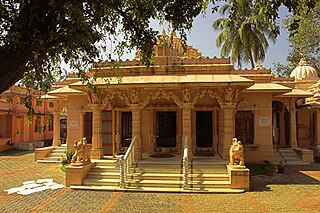
The Kochi Jain temple or Dharmanath Jain temple is a Jain temple in the Mattancherry in Kochi, Kerala.

Kadavumbhagam Mattancherry Synagogue aka Kadavumbhagam Synagogue is a Jewish synagogue located in Mattancherry, a locality in Kochi, in the coastal state of Kerala. It is one of the oldest extant synagogues in India, built in 1544 A.D. It was built by the Malabar Jews who are the oldest jewish settlers in India, believed to have arrived as traders in the ancient port city of Muziris. It was the second to be built in Mattancherry, after the Kochangadi Palli in 1344 A. D., and is one of three synagogues in the area. The others being the Thekkumbhagam Mattancherry Synagogue (extinct) and the Paradesi Synagogue of the Paradesi jews of Cochin.
